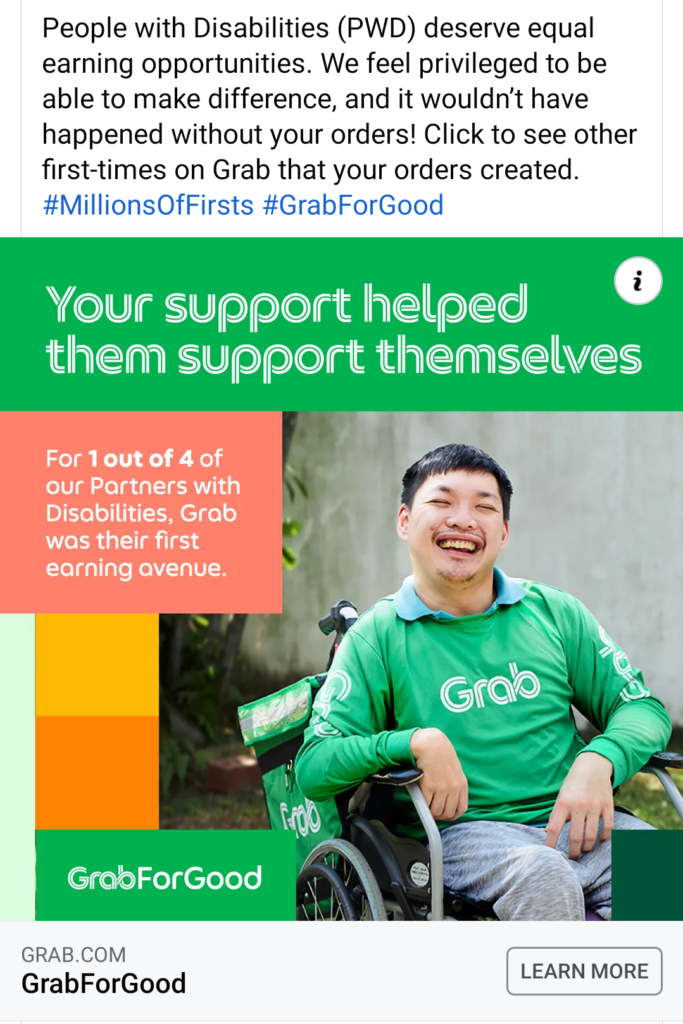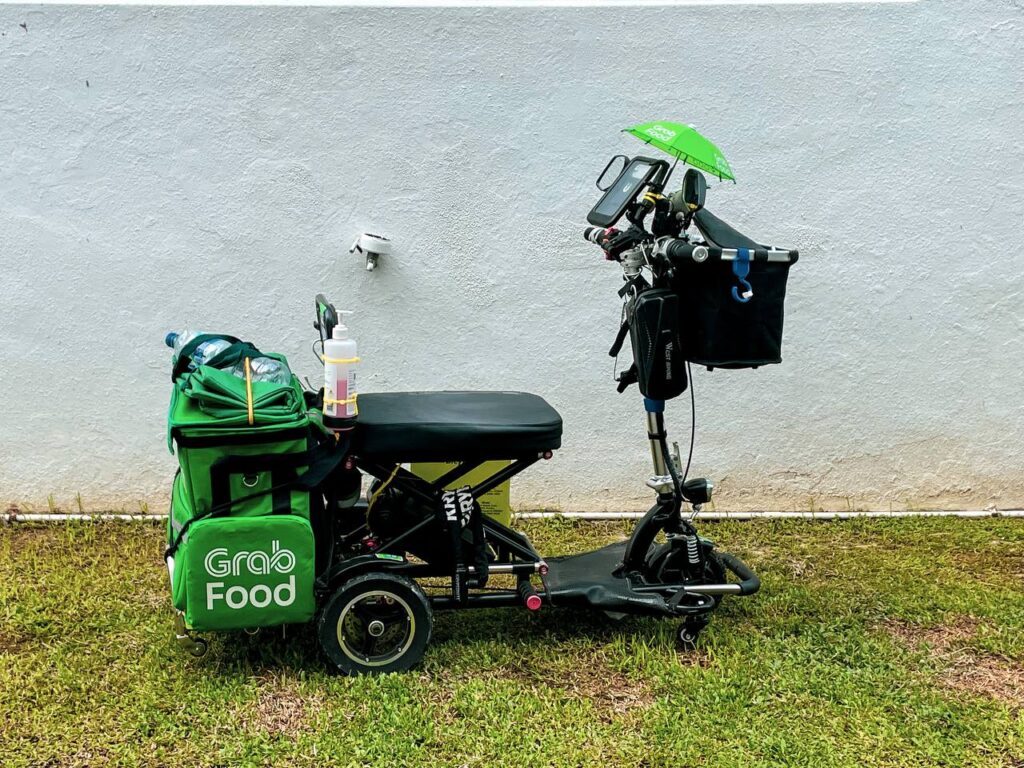CNM’s Dr Renyi Hong on Disability and Food Couriers in Singapore
May 17, 2023
You have seen them around: food delivery riders on mobility scooters and electric wheelchairs ferrying food across Singapore’s streets and malls. In 2021, I had the opportunity to meet Adam and nineteen other individuals with disabilities to discuss their firsthand experiences in this line of work. Adam, born with cerebral palsy, arrived to the interview on a Benoit Systemes electric wheelchair and a GrabFood bag. He had begun delivering food years ago on a manual wheelchair and was featured several times in Mandarin newspapers for his grit. Those papers, however, did not cover his accident. In 2020, a car knocked him down while delivering food in Orchard. The Benoit Systemes electric wheelchair came after, bought by his sister who feared for his safety.
Months after our initial meeting, Adam reached out again. His Benoit Systemes wheelchair had broken down, and his monthly earnings of about a thousand was insufficient to afford a new electric wheelchair. Out of desperation, he had bought a $460 second-hand scooter, only to find that the battery lasted only one delivery job. “Now I very sad,” he had told me.

Adam’s encounter relates to the complicated relationship that disability shares with gig work. During the same period of the interviews, Grab also published a series of Facebook ads. One circulated in disability communities depicted a person in a wheelchair with a GrabFood bag, accompanied with the caption: “For one out four of our partners with disabilities. Grab was their first earning avenue.”
These ads suggest that platforms are a technological source of economic empowerment, as if becoming a partner simply involves whipping out a phone and signing up on the app. Such a claim would have likely been received with cynicism if it featured abled-bodied workers, but with a disabled body, this claim appears luminous. “A future with disability is a future no one wants,” feminist disability scholar Alison Kafer tells us. Consequently, any promise on eradicating disability—like the ways that a platform can empower—tends to appear more appealing than it should.
The reality of Grab’s promise is more complicated. I should know. I tried to sign my physically disabled father with childhood polio to GrabFood in 2021 to get a sense of the process. After taking a digital test, he was directed to Midview City at Sin Ming, where Grab was headquartered. However, there is no accessible public transportation to the sprawling Midview City. One interviewee shared the journey’s difficulties—with stairs, slopes, sun, and rain—and how the scooter’s battery ran out as he was returning home. Simply enrolling on the platform, he said, felt like a victory.
The journey to Midview City symbolizes much of the unseen resilience required to participate in such work. Like Adam, many other delivery workers with disabilities started out with manual wheelchairs or crutches, and had to save or take donations to purchase electric mobility aids. Also, they have to navigate numerous unaccounted personal costs daily. For instance, the algorithms of platforms are designed for the able-bodied. They assign deliveries by distance, ignoring the possibility of portholes or the lack of barrier-free pavements in industrial estates. People with disabilities must independently navigate these challenges and find workarounds in a system built for the abled. Several have told me that they could never set their apps to automatically accept jobs because they need to assess if a task can be completed with their vehicles. However, opting for manual acceptance of jobs comes with its drawbacks, as it deprioritizes them in the task assignment process and excludes them from the gamified bonuses offered by platforms. As a result, those with disabilities receive an average of $800 to $1200 a month, about a third of what their abled-bodied counterparts earn.

During last year’s Christmas, I received a photo from Ken showcasing an impressive computer setup. “Thanks to GrabFood I can buy a computer,” he wrote. Ken, who has autism and health issues, delivers food on a mobility scooter and aspires to be a professional Twitch streamer. In our conversation, he highlighted the absence of alternative job opportunities that offer comparable wages. He asked, which job could accommodate his need to return home if he felt unwell immediately? Which could accommodate his weekly sessions to the hospital? Which service occupation would even allow him to work while seated?
Ken’s and Adam’s encounters and decisions reflect the larger structural issues residing behind disability and platform work in Singapore. For many individuals in this line of work, gig work is not the last resort, but the only resort. Most were dismissed or unable to stay at a conventional job for long. Much of this stems from discrimination or a lack of understanding. From this perspective, Grab’s assertion that this is the first earning avenue for a quarter of people with disabilities should spark alarm rather than applause. How is it that work debated on its sustainability and discouraged as a career could end up as the first and only choice for peoples with disabilities?
In my article, “Curative Platforms,” I explain how the history around disability in Singapore has promoted this blindsight—a tendency towards considering the opportunity for work for people with disabilities as an achievement without accounting for terms of their engagement. Together with disability researchers in Singapore, like Kuansong Victor Zhuang and Wong Meng Ee, I call for a thoughtful examination of the interplay between welfare and work. It is crucial to ensure that our system does not push individuals into states of desperation simply because they are unable to work or find suitable employment.
Meanwhile, platforms must take steps to make gig work safer and more inclusive for individuals with disabilities. Looking at disabilities requires us to look between the cracks. It requires us to see how ableist systems fail to address the needs of those who do not share the same capacities that abled people are assumed to have. This requirement would hold platforms to their word. If they promise empowerment, they must make sure that all processes are there to accommodate workers. Empowerment should not be limited to enrollment but extend throughout the entire working experience.
Unfortunately, the story of Adam’s wheelchair did not end happily. Left $460 poorer, Adam is left with task of saving up to purchase a new wheelchair while continuing to manually push himself for deliveries. Situations like this should be prevented. At a time when we are looking to enhance our social compact, such changes are economically, politically, and morally necessary.
 Dr Renyi HONG is Assistant Professor in the Department of Communications and New Media at the National University of Singapore. He is interested in labour and its relationships with affect, technology, and capitalism. His first monograph, Passionate Work, explores the uses of passion as a means of generating a milieu of endurance for those left out of the good life. His monograph in development, Bearable Media, examines the biopolitical relationship between human adaptation and computational media. His works can be found in Social Text, New Media & Society, European Journal of Cultural Studies, among others.
Dr Renyi HONG is Assistant Professor in the Department of Communications and New Media at the National University of Singapore. He is interested in labour and its relationships with affect, technology, and capitalism. His first monograph, Passionate Work, explores the uses of passion as a means of generating a milieu of endurance for those left out of the good life. His monograph in development, Bearable Media, examines the biopolitical relationship between human adaptation and computational media. His works can be found in Social Text, New Media & Society, European Journal of Cultural Studies, among others.

